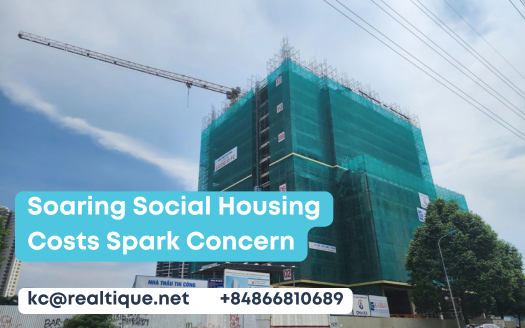Soaring Social Housing Costs Spark Concern
The escalating costs of social housing have become a pressing issue, as communities grapple with the financial strain placed on low-income families. With rental prices for high-rise developments soaring to 198,000 dong per square meter and average apartment costs approaching 14 million dong, the ability to secure affordable housing is increasingly jeopardized. Despite existing regulatory measures, there is a growing sentiment that these structures are inadequate in addressing the rapid market changes. As stakeholders consider potential solutions, the implications of this crisis on future housing policies warrant closer examination.
Table of Contents
The current state of social housing prices reflects a complex interplay of regulatory structures and market interactions in Hanoi.
The maximum rental price is set at 198,000 dong per square meter per month, translating to nearly 14 million dong for a 70 m² apartment. Prices are not uniform; they vary significantly based on building height and location.
For instance, buildings exceeding 30 floors command the highest rental rates, while those under 10 floors start at a minimum of 48,000 dong per m². Additionally, factors such as amenities and proximity to essential services further influence rental costs.
This pricing environment highlights the challenges faced by residents in accessing affordable housing amid fluctuating market conditions and regulatory constraints.
Pricing Structure and Guidelines
Frequently, the pricing structure for social housing in Hanoi is shaped by a combination of regulatory systems and market activity. This system aims to balance affordability with the operational costs of maintaining social housing projects.
Key aspects of the pricing guidelines include:
- Maximum rental price set at 198,000 dong per m² for buildings over 30 floors.
- Minimum rates starting at 48,000 dong per m² for buildings under 10 floors.
- Prices determined by the usable floor area and building height.
- Regulatory oversight provided by Decision 25/2019, ensuring compliance.
- Flexibility in adjusting rates according to current market conditions.
These elements collectively contribute to a structured approach to rental pricing, promoting transparency and fairness in the social housing sector.
Range of Rental Rates
Building on the established pricing structure, the range of rental rates for social housing in Hanoi reflects a systematic approach based on the height of the buildings and their usable floor area.
The maximum rental price is capped at 198,000 dong per square meter for buildings exceeding 30 floors, while rates for structures between 10 and 30 floors range from 49,000 to 146,000 dong.
Conversely, buildings under 10 floors feature a minimum rental rate of 48,000 dong per square meter.
Additional costs, such as maintenance and management fees, can further impact total rental expenses.
This structured pricing aims to guarantee transparency and fairness while addressing the diverse needs of residents within the social housing sector.
Regulatory Framework Overview
Regulatory structures play an essential role in shaping the rental environment for social housing in Hanoi. The system established by local authorities aims to create a balanced and transparent rental market, ensuring affordable housing options for residents.
Key elements of this system include:
- Adherence to pricing guidelines set forth in Decision 25/2019.
- Maximum rental limits based on building height and usable area.
- Mandatory approval processes involving the Department of Construction.
- Transparency measures to protect tenants from exploitative practices.
- Regular adjustments to pricing systems in response to market trends.
These regulations are vital for maintaining a stable and fair rental market, ultimately addressing the growing concerns regarding social housing costs in the city.
Future Prospects for Social Housing
There is a growing recognition of the urgent need for social housing in Hanoi, as the city grapples with rising population densities and escalating living costs.
The municipal authorities have set ambitious targets, aiming to complete 18,700 social housing units by 2025. However, current progress is concerning, with only 9% of the target units constructed.
To address this shortfall, ongoing projects and timely execution are paramount. A new pricing structure is under consideration, which seeks to standardize rental rates while accommodating market fluctuations.
The implementation of transparent regulations will be critical to guarantee compliance and cultivate trust between landlords and tenants.
Ultimately, the future of social housing in Hanoi hinges on effective policy execution and a commitment to affordable living solutions.





